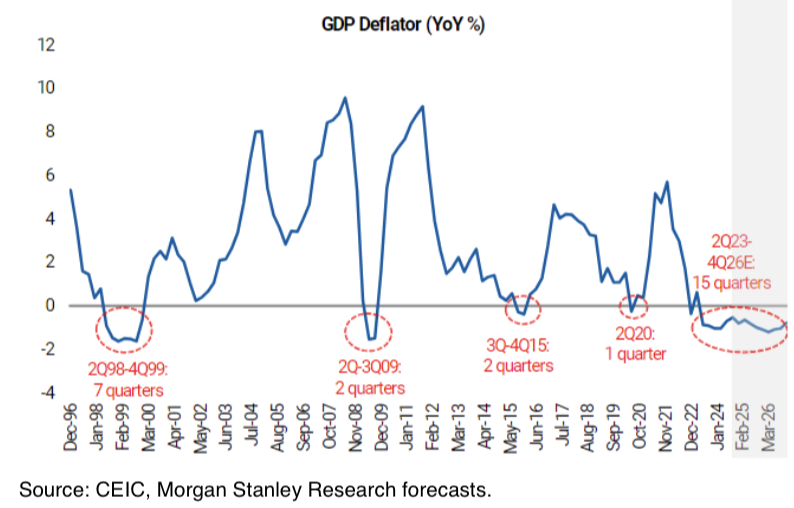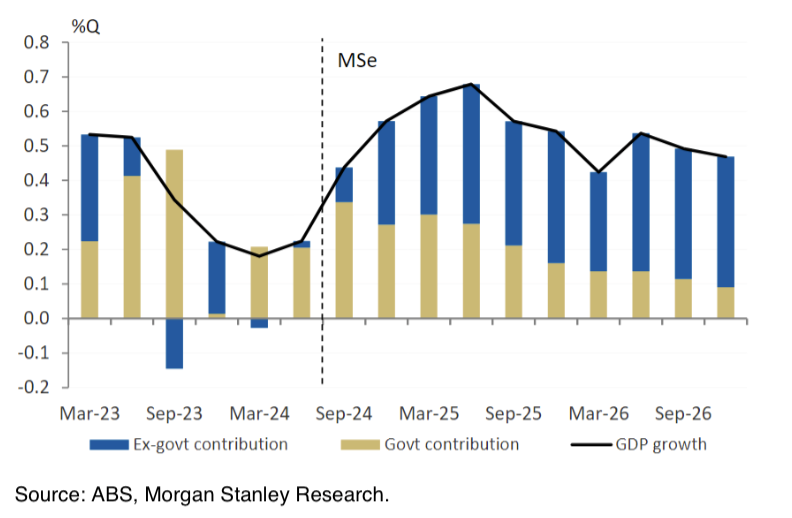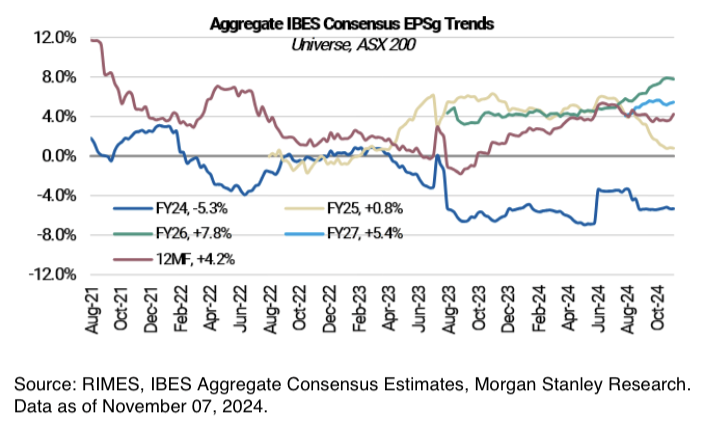Why we're continuing to add stocks and credit to portfolios in 2025
We currently see another couple of years of near-3% global growth. In the US, we expect growth to slow in 2025 owing to a fading impetus from fiscal policy, the lagged effects of still-restrictive monetary policy, and the imposition of new tariffs and immigration restrictions. We also forecast China’s growth to underperform next year, given still insufficient consumption stimulus, and the looming risk of US tariff hikes.
China's path to reflation will remain a long and ‘bumpy’ journey

On the inflation front, we generally see additional, although slower, progress next year. In the US, both lower immigration and tariffs slow disinflation relative to our prior forecasts and we see inflation remaining slightly above target in the next two years. As a result, we have the Federal Reserve lowering rates until its May 2025 meeting and going on hold thereafter.
Inflation in developed markets trends lower as US inflation stalls amid policy changes

In Australia, growth is expected to improve but remains below trend, with government spending the key driver ahead of the Federal Election. Progress on unemployment and inflation is slow, with the Reserve Bank of Australia starting to cut rates gradually from May 2025.
As a result, 2025 should be another good year for risk assets: moderate growth and disinflation support elevated valuations. A deregulation focus and continued key central bank easing are additional tailwinds. However, we believe that markets will be sensitive to the substance, severity, and sequencing of fiscal, trade, as well as immigration policies of the incoming US administration, all of which could drive divergent investment outcomes.
Australian economic outlook
In Australia, our economists expect economic growth will improve sequentially over 2025 but remain below trend. While households' real incomes will improve due to lower taxes and inflation, we foresee only a modest pass-through to spending as consumers stay cautious. Savings rates are likely to rise modestly as house prices, and therefore household wealth flattens out.
Business investment grows solidly given robust nominal activity and falling capital-labour ratios, while dwelling investment only picks up meaningfully later in 2025 as rate cuts come through.
Migration slows back to pre-COVID run rates, providing a headwind to services exports and broader domestic demand.
Government spending is expected to continue driving the majority of economic growth, particularly ahead of the Federal election due by May when we expect both parties will propose demand-supportive policies.
Government spending remains a key growth driver near-term in Australia

The labour market is strong and we expect this will remain the case through 1H25 with solid but slowing job growth that continues to be government-driven. Alongside some assumed increases in participation, this sees the unemployment rate continue to grow very gradually.
We continue to expect a gradual disinflation path over the coming year. Wage growth has peaked but is expected to hold around 3.5% over 2025, limiting services disinflation particularly while productivity remains poor.
In this context, our economists believe the RBA will continue to lag other central banks in easing over the next six months, with the first interest rate cut only expected to come in May 2025, after the Federal election. This is forecast to lead to 3 rate cuts in 2025 (May, August, November) and take the cash rate to 3.60%, around the RBA's estimate of neutral.
Our ASX outlook
We see a similar outcome for Australian stocks next year as it was this year: A constructive outlook for Australian Equities, although still likely to lag the key DM performers (the US in particular.)
Our strategists have lifted their price target for end-2025 to 8500 for the ASX 200. The recent rally took the market above Morgan Stanley's previous 8,100 price target. However, the earnings our strategists assumed would get us to these levels were around 13% above current expectations - and FY25e EPS growth for the market now sits close to zero.
Aggregate domestic consensus earnings growth in FY25e has been challenged, however the forward years are providing more upside

Should this be cause for concern? The short answer is yes if valuations have little buffer to absorb endogenous disappointment or any exogenous shock. Indeed, for any meaningful upside from here, earnings trends need to start to improve.
Where we're favourable in global equities
In the US, we continue to prefer quality cyclical stocks and operational efficiency. Financials remain our top pick within the quality cyclical space while we are underweight in the consumer sector – both discretionary goods and staples. In Europe, we prefer ex-China exposure, US local goods exposure over tariff-exposed stocks, and high pricing power.
Rising US economic surprise is supportive of pro-cyclical rotation

We stay NEUTRAL on Small versus Large caps. While the 2016 playbook would suggest Small caps could see a period of outperformance following the US election, we believe there are a couple of differences relative to this period that are worth considering.
Where we're investing across other assets
We continue to build an overweight (OW) in equities given our broadly constructive 12-month outlook. Valuations are elevated, but valuations are richer than average because fundamentals are better than average. In particular, moderate growth, disinflation, deregulation, and monetary policy easing are favorable for risk assets, and particularly benefit US corporates, even as uncertainty around the impact of other policy changes lingers. An intact secular reflation narrative means we continue to like Japanese equities. We prefer Australian equities to European equities, which we downgrade to Neutral on tariff risks and China exposure. Emerging Markets (EM) remain our least-favoured market on increasing trade tensions.
Falling interest rates around the world mean OW duration towards most government bonds in 1H25 (ex-Australia). But despite the positive expected returns, we are lightly positioning in government bonds because Equities and Credit look more attractive. We concentrate our duration in International bonds and remain very UW in Australia, given the policy differential.
We believe that the credit strategy in 2025 will be related to turning cautious eventually (but not immediately), as we expect a stronger 1H and weaker 2H. Correctly identifying credits, curve positions, and sectors will be key, the impact of which matters more when the overall market offers less. Credit is still an attractive asset class, although ‘living on borrowed time’ in our view.
In Energy, we expect a period of lower crude oil prices in 2025 as a combination of OPEC and non-OPEC supply growth outweighs slowing demand growth.
In metals, copper remains our top pick given inventories drawing and demand recovering with lower prices. However, the US election and any China policy response may bring uncertainty.
We see limited further upside in gold - rate cuts are expected to be a tailwind but physical demand is starting to come under pressure.
Finally, we continue to like Alternative Investments the most in the current environment and are positioning with a mix of commodities (including gold), and hedge funds as well as select private investments to enhance returns, lower portfolio volatility and manage equity beta risk.
Learn more about Morgan Stanley Wealth Management
Morgan Stanley's fundamental objective is to provide first-class service while helping our clients achieve their financial goals. Our Financial Advisers harness the firm’s global resources and intellectual capital to help create a financial plan tailored to you and your goals. Learn more here

